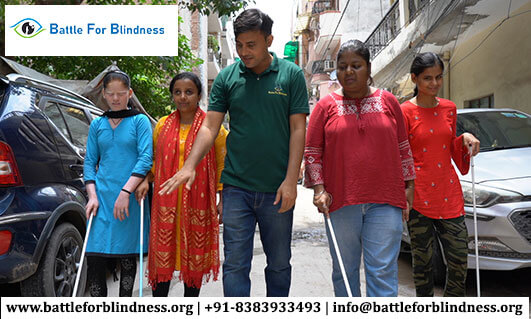
In today’s rapidly advancing digital world, inclusivity and accessibility are at the forefront of technological innovations. For blind and visually impaired girls, these advancements are breaking barriers, empowering them to participate in education, careers, and social interactions. Leveraging assistive technologies, organizations, developers, and innovators are creating groundbreaking tools that bring inclusivity to the digital realm.
This article explores cutting-edge technologies and tools that are transforming the lives of blind girls worldwide, offering independence, confidence, and equal opportunities.
The Growing Importance of Accessible Technology
For visually impaired individuals, technology is more than a luxury; it is a life-changing necessity. Innovations in accessibility tools now provide blind girls access to quality education, digital communication, and employment opportunities, helping them overcome societal barriers. According to the World Health Organization (WHO), over 253 million people live with visual impairment globally, and a significant percentage of them are women and girls facing gender-based challenges.
The inclusion of AI-powered assistive tools and screen-reading software ensures that visually impaired girls are no longer left behind in the digital transformation.
Innovative Tools Transforming the Lives of Blind Girls
1. Screen Readers and Text-to-Speech Technology
-
Screen readers such as JAWS (Job Access With Speech), NVDA (NonVisual Desktop Access), and mobile applications like VoiceOver (iOS) and TalkBack (Android) are enabling blind girls to interact with computers and smartphones seamlessly.
-
These tools convert text into speech, helping users navigate apps, browse the web, and even compose emails or messages without relying on sight.
2. Braille Technology
-
The integration of refreshable Braille displays and Braille keyboards is transforming education for blind girls. Devices like the Orbit Reader 20 and BrailleNote Touch Plus allow students to read digital text in Braille format.
-
By connecting to laptops, smartphones, or tablets, these tools provide an effective way to learn, write, and engage in education.
3. AI-Powered Assistive Applications
-
Artificial Intelligence (AI) is playing a crucial role in bridging accessibility gaps. Applications like Seeing AI (by Microsoft) and Envision AI can describe surroundings, read printed text, identify objects, and even recognize faces.
-
These tools are particularly useful for blind girls, empowering them with real-time information about their environments, increasing safety, and fostering independence.
4. Wearable Assistive Devices
-
Innovations such as smart glasses and haptic feedback devices are revolutionizing mobility for visually impaired individuals. Tools like the OrCam MyEye use AI to read text, recognize products, and identify people, all through a wearable device.
-
Similarly, smart canes like the WeWalk Smart Cane use GPS, ultrasonic sensors, and voice navigation to assist blind girls in navigating streets independently and confidently.
5. Digital Learning Platforms with Accessibility Features
-
Educational tools like Google Classroom, Khan Academy, and Microsoft Teams now include accessibility features such as screen-reader compatibility and keyboard shortcuts.
-
These platforms ensure blind girls have equal opportunities to access education and online learning, creating a level playing field for all students.
6. Voice-Activated Virtual Assistants
-
Assistants like Amazon Alexa, Google Assistant, and Apple Siri are helping blind girls perform day-to-day tasks like setting reminders, sending messages, and accessing online resources using only voice commands.
-
This technology fosters independence and reduces reliance on others.
Empowering Blind Girls Through Inclusive Tech: Real-Life Stories
Case Study 1: Ayesha’s Journey to Education and Independence Ayesha, a 14-year-old visually impaired girl from India, uses refreshable Braille displays and AI tools like Envision AI to complete her school assignments. With the help of screen readers, she confidently navigates digital platforms, making her dream of becoming a writer achievable.
Case Study 2: Sara’s Exploration of STEM Sara, a tech-savvy teenager from the UK, uses OrCam MyEye and screen-reading software to access complex study materials in STEM subjects. With accessible educational tools, she aspires to pursue a career in technology and innovation.
The Role of Organizations in Promoting Accessible Technology
Several organizations and tech giants are championing inclusivity by investing in accessible tools and programs. Key players include:
-
Microsoft: Their AI for Accessibility initiative focuses on empowering people with disabilities through technology.
-
Google: Google ensures its tools like Android TalkBack and ChromeVox enhance digital accessibility.
-
Apple: With built-in tools like VoiceOver, Apple devices are some of the most accessible for visually impaired users.
-
NGOs: Organizations like RNIB (Royal National Institute of Blind People) and Perkins School for the Blind offer resources, tools, and support for visually impaired girls to achieve their potential.
Challenges and Future Scope of Accessible Technologies
While there is remarkable progress in developing tools for blind girls, challenges such as affordability, accessibility to rural areas, and technology literacy remain. Bridging these gaps requires collaborative efforts between:
-
Governments: To implement policies promoting affordable assistive technologies.
-
Private Sector: To innovate and scale inclusive tech tools.
-
Nonprofits: To spread awareness and provide training to visually impaired individuals.
The future of assistive technology promises even greater innovations such as AI-driven haptic feedback, augmented reality tools, and machine learning-based accessibility solutions.
Conclusion: Tech for Empowerment and Inclusion
In the evolving world of technology, innovative tools are transforming the lives of blind girls, empowering them to embrace education, independence, and equality. With AI, wearable devices, and accessible software at the forefront, technology is creating a future where visual impairment is no longer a barrier.
By fostering innovation and accessibility, we can ensure that every blind girl has the tools and resources to thrive in the digital era. Inclusive technology is not just about transformation; it is about building a world where no one is left behind.





